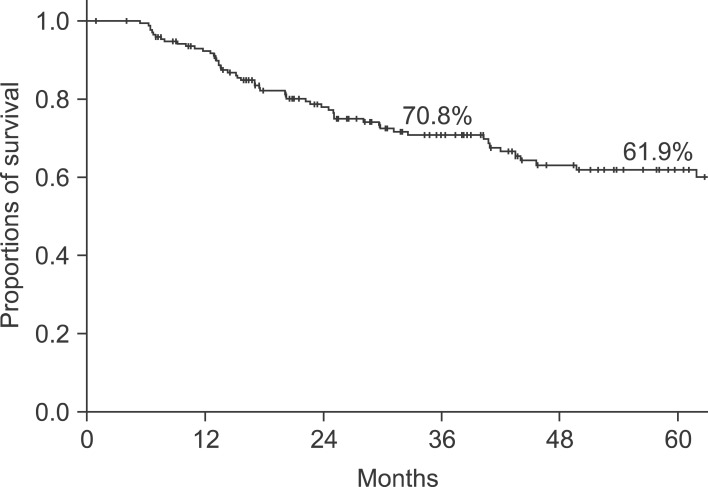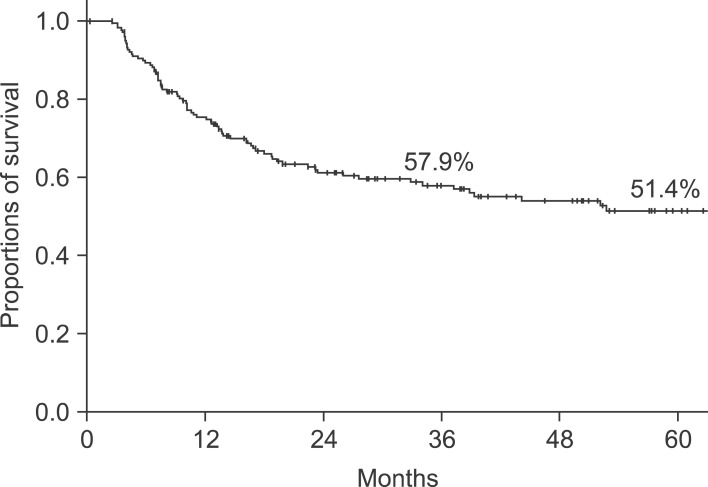Korean J Hepatobiliary Pancreat Surg.
2011 Aug;15(3):171-178. 10.14701/kjhbps.2011.15.3.171.
Adenocarcinoma of the ampulla of Vater: predictors of survival and recurrence after curative radical resection
- Affiliations
-
- 1Department of Surgery, Samsung Medical Center, Sungkyunkwan University School of Medicine, Seoul, Korea. dw7722.choi@samsung.com
- KMID: 2130989
- DOI: http://doi.org/10.14701/kjhbps.2011.15.3.171
Abstract
- BACKGROUNDS/AIMS
Because of low incidence rates, there have been few reports on the patterns of and risk factors for recurrence after curative resection of the ampulla of Vater (AoV) cancer. The aim of this study was to characterize patterns of recurrence and to evaluate risk factors affecting survival rates and recurrence after curative resection.
METHODS
Medical records of 181 patients who had undergone pancreaticoduodenectomy with curative intent for AoV adenocarcinoma between December 1994 and March 2010 at Samsung Medical Center were retrospectively reviewed. Factors influencing on overall survival rate, recurrence rates, and recurrence patterns were analyzed.
RESULTS
Lymph node metastases and high preoperative serum carcinoembryonic antigen (CEA) level >5 ng/ml were identified as independent factors affecting overall survival (p=0.006, p<0.001, respectively). Among the 181 patients, 69 developed local or distant recurrence within 3 years after curative resection. Lymph node metastasis, preoperative serum CEA level >5 ng/ml, and total bilirubin level >1.5 mg/dl were identified as independent prognostic factors of recurrence after curative resection (p=0.008, p<0.001, p=0.003, respectively).
CONCLUSIONS
AoV adenocarcinoma has a better prognosis than other periampullary carcinomas, but still has a high recurrence rate, especially during the first three years after curative radical resection. Therefore, careful follow-up is needed during the first 3 years, especially for the higher risk group. Further study of adjuvant therapy to decrease recurrence after curative resection is now warranted.
MeSH Terms
Figure
Reference
-
1. Albores-Saavedra J, Schwartz AM, Batich K, Henson DE. Cancers of the ampulla of Vater: demographics, morphology, and survival based on 5,625 cases from the SEER program. J Surg Oncol. 2009; 100:598–605. PMID: 19697352.
Article2. Howe JR, Klimstra DS, Moccia RD, Conlon KC, Brennan MF. Factors predictive of survival in ampullary carcinoma. Ann Surg. 1998; 228:87–94. PMID: 9671071.
Article3. Hatzaras I, George N, Muscarella P, Melvin WS, Ellison EC, Bloomston M. Predictors of survival in periampullary cancers following pancreaticoduodenectomy. Ann Surg Oncol. 2010; 17:991–997. PMID: 20108122.
Article4. Yeo CJ, Sohn TA, Cameron JL, Hruban RH, Lillemoe KD, Pitt HA. Periampullary adenocarcinoma: analysis of 5-year survivors. Ann Surg. 1998; 227:821–831. PMID: 9637545.5. Carter JT, Grenert JP, Rubenstein L, Stewart L, Way LW. Tumors of the ampulla of Vater: histopathologic classification and predictors of survival. J Am Coll Surg. 2008; 207:210–218. PMID: 18656049.
Article6. Qiao QL, Zhao YG, Ye ML, et al. Carcinoma of the ampulla of Vater: factors influencing long-term survival of 127 patients with resection. World J Surg. 2007; 31:137–143. PMID: 17171495.
Article7. Allema JH, Reinders ME, van Gulik TM, et al. Results of pancreaticoduodenectomy for ampullary carcinoma and analysis of prognostic factors for survival. Surgery. 1995; 117:247–253. PMID: 7878528.
Article8. Kim K, Chie EK, Jang JY, et al. Role of adjuvant chemoradiotherapy for ampulla of Vater cancer. Int J Radiat Oncol Biol Phys. 2009; 75:436–441. PMID: 19394162.
Article9. Morak MJ, van der Gaast A, Incrocci L, et al. Adjuvant intra-arterial chemotherapy and radiotherapy versus surgery alone in resectable pancreatic and periampullary cancer: a prospective randomized controlled trial. Ann Surg. 2008; 248:1031–1041. PMID: 19092348.10. Morak MJ, Pek CJ, Kompanje EJ, Hop WC, Kazemier G, van Eijck CH. Quality of life after adjuvant intra-arterial chemotherapy and radiotherapy versus surgery alone in resectable pancreatic and periampullary cancer: a prospective randomized controlled study. Cancer. 2010; 116:830–836. PMID: 20029974.11. Woo SM, Ryu JK, Lee SH, et al. Feasibility of endoscopic papillectomy in early stage ampulla of Vater cancer. J Gastroenterol Hepatol. 2009; 24:120–124. PMID: 19032444.
Article12. Yoon SM, Kim MH, Kim MJ, et al. Focal early stage cancer in ampullary adenoma: surgery or endoscopic papillectomy? Gastrointest Endosc. 2007; 66:701–707. PMID: 17905011.
Article13. Demetriades H, Zacharakis E, Kirou I, et al. Local excision as a treatment for tumors of ampulla of Vater. World J Surg Oncol. 2006; 4:14. PMID: 16524478.
Article14. Yoon YS, Kim SW, Park SJ, et al. Clinicopathologic analysis of early ampullary cancers with a focus on the feasibility of ampullectomy. Ann Surg. 2005; 242:92–100. PMID: 15973106.
Article15. Chiche L, Alkofer B, Parienti JJ, et al. Usefulness of follow-up after pancreatoduodenectomy for carcinoma of the ampulla of Vater. HPB (Oxford). 2007; 9:140–145. PMID: 18333130.
Article16. Park JS, Yoon DS, Kim KS, et al. Factors influencing recurrence after curative resection for ampulla of Vater carcinoma. J Surg Oncol. 2007; 95:286–290. PMID: 17326125.
Article17. Woo SM, Ryu JK, Lee SH, et al. Recurrence and prognostic factors of ampullary carcinoma after radical resection: comparison with distal extrahepatic cholangiocarcinoma. Ann Surg Oncol. 2007; 14:3195–3201. PMID: 17710498.
Article18. Westgaard A, Tafjord S, Farstad IN, et al. Pancreatobiliary versus intestinal histologic type of differentiation is an independent prognostic factor in resected periampullary adenocarcinoma. BMC Cancer. 2008; 8:170. PMID: 18547417.
Article19. de Paiva Haddad LB, Patzina RA, Penteado S, et al. Lymph node involvement and not the histophatologic subtype is correlated with outcome after resection of adenocarcinoma of the ampulla of Vater. J Gastrointest Surg. 2010; 14:719–728. PMID: 20107918.
Article20. Sierzega M, Nowak K, Kulig J, Matyja A, Nowak W, Popiela T. Lymph node involvement in ampullary cancer: the importance of the number, ratio, and location of metastatic nodes. J Surg Oncol. 2009; 100:19–24. PMID: 19384907.
Article21. Iacono C, Verlato G, Zamboni G, et al. Adenocarcinoma of the ampulla of Vater: T-stage, chromosome 17p allelic loss, and extended pancreaticoduodenectomy are relevant prognostic factors. J Gastrointest Surg. 2007; 11:578–588. PMID: 17468917.
Article22. Duffy JP, Hines OJ, Liu JH, et al. Improved survival for adenocarcinoma of the ampulla of Vater: fifty-five consecutive resections. Arch Surg. 2003; 138:941–948. PMID: 12963649.23. Falconi M, Crippa S, Domínguez I, et al. Prognostic relevance of lymph node ratio and number of resected nodes after curative resection of ampulla of Vater carcinoma. Ann Surg Oncol. 2008; 15:3178–3186. PMID: 18712568.
Article24. Bogoevski D, Chayeb H, Cataldegirmen G, et al. Nodal microinvolvement in patients with carcinoma of the papilla of Vater receiving no adjuvant chemotherapy. J Gastrointest Surg. 2008; 12:1830–1837. PMID: 18791769.
Article25. Todoroki T, Koike N, Morishita Y, et al. Patterns and predictors of failure after curative resections of carcinoma of the ampulla of Vater. Ann Surg Oncol. 2003; 10:1176–1183. PMID: 14654474.
Article26. Nakao A, Harada A, Nonami T, et al. Prognosis of cancer of the duodenal papilla of Vater in relation to clinicopathological tumor extension. Hepatogastroenterology. 1994; 41:73–78. PMID: 8175122.27. Dorandeu A, Raoul JL, Siriser F, et al. Carcinoma of the ampulla of Vater: prognostic factors after curative surgery: a series of 45 cases. Gut. 1997; 40:350–355. PMID: 9135524.
Article28. Terasawa H, Uchiyama K, Tani M, et al. Impact of lymph node metastasis on survival in patients with pathological T1 carcinoma of the ampulla of Vater. J Gastrointest Surg. 2006; 10:823–828. PMID: 16769538.
Article
- Full Text Links
- Actions
-
Cited
- CITED
-
- Close
- Share
- Similar articles
-
- A Case of Hepatectomy for Liver Metastasis after Pancreatoduodenectomy for Carcinoma of Ampulla of Vater
- Predictors of early recurrence following a curative resection in patients with a carcinoma of the ampulla of Vater
- A Case of a Collision Tumor in the Ampulla of Vater with an Adenocarcinoma and a Large Cell Neuroendocrine Carcinoma
- The Outcomes of Curative Resection for Ampulla of Vater Cancer
- Concurrent occurrence of adenocarcinoma and neuroendocrine type small cell carcinoma in the ampulla of Vater



